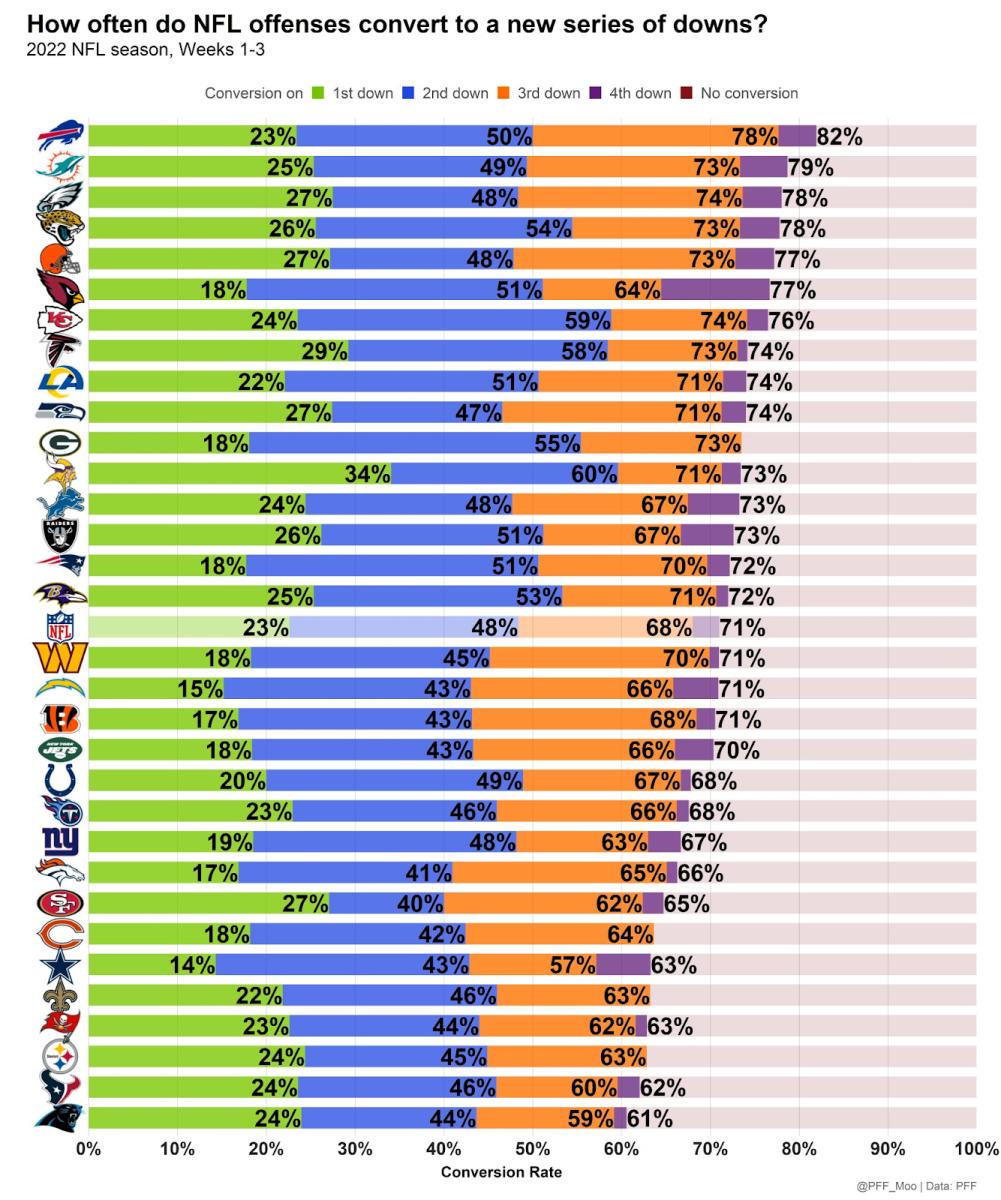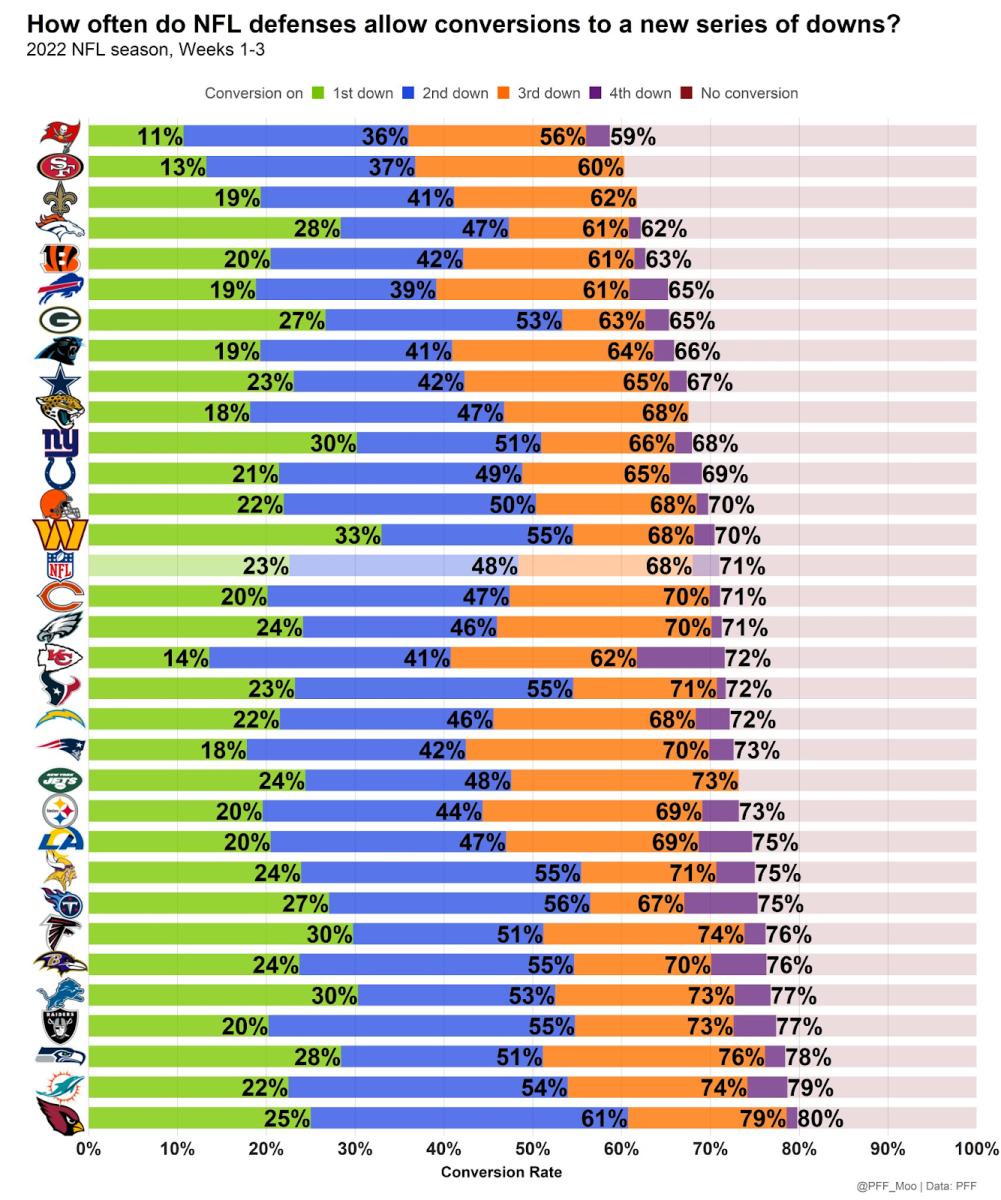The importance of a 2-1 start and the Vikings' looming third down regression

The Minnesota Vikings are back over .500 in what has been unfamiliar territory over the past several years. It’s certainly been a roller coaster ride, from joyful exuberance in Week 1 to deflation in Week 2. The Week 3 matchup against the Lions was a roller coaster in and of itself.
Let’s take a look at some interesting statistics to better contextualize where the Vikings stand and how they’ve performed.
The Week 3 escape and what it means for the future
By now you’ve heard Dan Campbell’s quotes calling his decision to kick a field goal on fourth down in the fourth quarter up three points a mistake (read this Eric Eager piece if you want more information on why it was) and Kirk Cousins’s proclamation that the Vikings need to be better. The 28-24 win counts the same as any other, and Minnesota needed big plays on both offense and defense to pull it out, but clearly, the team is not operating as if everything is perfect. That’s wise.
PFF’s Kevin Cole computes “adjusted scores” every week, which essentially measures what the score should have been given the effectiveness of both teams. Cole does this by projecting points using each team’s success rates running and passing the ball. The adjusted score found Detroit should have won 27-23.
Another way to represent the Lions’ missed opportunity is this chart from Ben Baldwin. The chart looks at expected points added (EPA) per play and Detroit was better on offense and defense, one of only three games in Week 3 in which the losing team notched better EPA numbers than their opponent. The Chiefs lost to the Colts despite a healthy gap in EPA and the Titans edged the Raiders despite a similar disparity to the Vikings.

The Vikings’ ability to flip that adjusted score result is in no small part due to Campbell’s decision to kick. The 4th down decision was the worst in the NFL in Week 3, per Baldwin.

With less than three minutes to play, ESPN Analytics gave the Lions a 93.2 percent win probability, and the Lions’ win percentage was still 66 percent when Austin Seibert missed the 54-yard field goal, exhibiting that it still required late-game execution from the Vikings. Still, it was a worse decision than going for it or even punting.
However you’d like to weigh the Vikings' win – giving credit to Minnesota or taking it away from Detroit – the result is the same. The Vikings are 2-1 and are in a really good spot heading into October.
Per Football Outsiders, Minnesota’s schedule for the first three weeks was the third-toughest in the NFL and its remaining schedule is currently the fourth-easiest. Compared to the other 2-1 teams in the NFC North, the Vikings look favorable. Green Bay’s schedule through three weeks ranked 14th in the NFL (easier than MIN) and they have the 12th-easiest schedule remaining. Chicago faced the 12th-hardest schedule so far and has the 10th-hardest schedule remaining.
That’s also shown in this chart from PFF’s Ben Brown, which compares PFF’s preseason playoff simulations to now. The Vikings have made the fourth-biggest leap in playoff probability. Football Outsiders has Minnesota’s odds of making the playoffs at 65 percent.

It’s obviously very early to be thinking playoffs, but the more wins the Vikings stack up, the bigger math problem it becomes when envisioning how they miss the playoffs. Take care of business against the Saints and Bears and suddenly Minnesota would be 4-1 and 3-0 in the division. With a weakened NFC and a seventh playoff spot, hanging around .500 will keep most teams in the playoff hunt and the Vikings would surely be on track to do that.
Is regression coming on 3rd down?
The Vikings' offense is quite the mixed bag of results. The Vikings rank 16th in points and 18th in yards per game. They rank 11th in Football Outsiders’ DVOA and 4th in offensive PFF grade.
That’s also the case on a down-to-down basis. This chart, courtesy of PFF’s Timo Riske, shows the Vikings generate first downs at a 73 percent clip, just slightly above average. Notably, however, is Minnesota’s performance on first and second down. The Vikings are the best in the NFL at converting first downs while on first down. They’re at 34 percent, no other team is above 29 percent and the NFL average is 23 percent.

The effectiveness tails off a bit on second down, but they still convert more than any NFL team when combining 1st and 2nd down. Where the issues arise are on third down. Minnesota has converted on just 29 percent (10-34) of third downs this year, that’s 26th in the NFL. That drops the Vikings’ overall effectiveness considerably.
It’s visualized another way here from Baldwin, showing Minnesota has one of the best EPA/play on early downs and one of the worst on later downs.
The good news for the Vikings, which Riske points out, is those third down conversions often regress towards the mean. For one, third downs are happening much less frequently than early-down plays, giving this stat a high level of variance on such a small sample size. Early downs also give the offense more freedom to play how they want to play and give a clearer picture of how effective the offense can be.
Given how well the Vikings are playing on early downs, it’s not a big leap of faith to say the third-down offense will come around.
There are always caveats. More so than any other down, third downs require a further depth of target as defense commonly sits on the line to gain and force a short completion. Cousins’ average air yards to the sticks is -2.2, sixth-lowest in the league, per Next Gen Stats. That means he’s routinely throwing short of the line to gain and forcing receivers to make a play to get the first down. Cousins also ranks 19th in Next Gen’s aggressiveness stat. These tendencies are fundamentally restrictive to converting on third downs and put much more pressure on the coaching staff to scheme up late-down YAC opportunities. Both Cousins and the coaching staff will need to adapt for the third down woes to be corrected.
While positive regression may be on the horizon for Minnesota’s offense, the opposite may be true for the defense.
Through three games, the Vikings have allowed opponents to convert on 34 percent of third downs. Last season, the Buffalo Bills were the best defense in the NFL and allowed conversions on 33 percent of third downs. Then, there's this chart from Riske, which is the same as the one above but for defenses and it’s showing the opposite situation. Minnesota’s defense is one of the worst at allowing conversions on early downs and is being bolstered by its third-down defense.

Under Mike Zimmer, Minnesota was always among the better third-down defenses. Even last year, the Vikings ranked fourth in allowed third down conversion rate. It remains to be seen whether Ed Donatell can draw up the same type of schematic advantages and produce similar results. If he can’t buck the trend as Zimmer did, the defense may get worse.
History of London games
Quickly I thought it would be interesting to see if past London games give any insight into how this week will go for Minnesota.
History says favorites do well both straight up and against the spread. Per FanSided, favorites are 21-8-1 straight up and 18-12 against the spread since 2007. The Vikings are currently -2.5 favorites in the betting markets.
The games are also frequently low scoring. The under in the betting market is 8-4 in the last 12 games. The over/under for Sunday is 47.5.
Related: This is why the Vikings kept Alexander Mattison
Related: Justin Jefferson faces another lockdown corner in London
